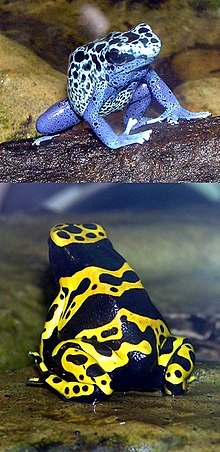Poison Dart Frogs

Poison dart frog (also known as dart-poison frog, poison frog or formerly known as poison arrow frog) is the common name of a group of frogs in the family Dendrobatidae which are native to tropical Central and South America. These species are diurnal and often have brightly colored bodies. This bright coloration is correlated with the toxicity of the species, making them aposematic. Some species of the family Dendrobatidae exhibit extremely bright coloration along with high toxicity, while others have cryptic coloration with minimal to no amount of observed toxicity. The species that have great toxicity derive this feature from their diet of ants, mites and termites. However, other species that exhibit cryptic coloration, and low to no amounts of toxicity, eat a much larger variety of prey. Many species of this family are threatened due to human infrastructure encroaching on their habitats.
These amphibians are often called "dart frogs" due to the Native Americans' use of their toxic secretions to poison the tips of blowdarts. However, out of over 170 species, only four have been documented as being used for this purpose (curare plants are more commonly used for Native American darts) all of which come from the genus Phyllobates, which is characterized by the relatively large size and high levels of toxicity of its members.
Most species of poison dart frogs are small, sometimes less than 1.5 cm (0.59 in) in adult length, although a few grow up to 6 cm (2.4 in) in length. They weigh 1 oz. on average.[7] Most poison dart frogs are brightly colored, displaying aposematic patterns to warn potential predators. Their bright coloration is associated with their toxicity and levels of alkaloids. For example, frogs of the genus Dendrobates have high levels of alkaloids, whereas Colostethus species are cryptically colored and are not toxic.
Poison dart frogs are an example of an aposematic organism. Their bright coloration advertises unpalatability to potential predators. Aposematism is currently thought to have originated at least four times within the poison dart family according to phylogenetic trees, and dendrobatid frogs have since undergone dramatic divergences – both interspecific and intraspecific – in their aposematic coloration. This is surprising given the frequency-dependent nature of this type of defense mechanism.
Adult frogs lay their eggs in moist places, including on leaves, in plants, among exposed roots, and elsewhere. Once the eggs hatch, the adult piggybacks the tadpoles, one at a time, to suitable water: either a pool, or the water gathered in the throat of bromeliads or other plants. The tadpoles remain there until they metamorphose, in some species fed by unfertilized eggs laid at regular intervals by the mother.
Habitat
Poison dart frogs are endemic to humid, tropical environments of Central and South America. These frogs are generally found in tropical rainforests, including in Bolivia, Costa Rica, Brazil, Colombia, Ecuador, Venezuela, Suriname, French Guiana, Peru, Panama, Guyana, Nicaragua, and Hawaii (introduced).
Natural habitats include moist, lowland forests (subtropical and tropical), high-altitude shrubland (subtropical and tropical), moist montanes and rivers (subtropical and tropical), freshwater marshes, intermittent freshwater marshes, lakes and swamps. Other species can be found in seasonally wet or flooded lowland grassland, arable land, pastureland, rural gardens, plantations, moist savanna and heavily degraded former forest. Premontane forests and rocky areas have also been known to hold frogs. Dendrobatids tend to live on or close to the ground, but also in trees as much as 10 m (33 ft) from the ground.
Reproduction
Ranitomeya imitator's developmental life stages
Many species of poison dart frogs are dedicated parents. Many poison dart frogs in the genera Oophaga and Ranitomeya carry their newly hatched tadpoles into the canopy; the tadpoles stick to the mucus on the backs of their parents. Once in the upper reaches of the rainforest trees, the parents deposit their young in the pools of water that accumulate in epiphytic plants, such as bromeliads. The tadpoles feed on invertebrates in their nursery, and their mother will even supplement their diet by depositing eggs into the water. Other poison frogs lay their eggs on the forest floor, hidden beneath the leaf litter. Poison frogs fertilize their eggs externally; the female lays a cluster of eggs and a male fertilizes them afterward, in the same manner as most fish. Poison frogs can often be observed clutching each other, similar to the manner most frogs copulate. However, these demonstrations are actually territorial wrestling matches. Both males and females frequently engage in disputes over territory. A male will fight for the most prominent roosts from which to broadcast his mating call; females fight over desirable nests, and even invade the nests of other females to devour competitor's eggs.
The operational sex ratio in the poison dart frog family is mostly female biased. This leads to a few characteristic behaviors and traits found in organisms with an uneven sex ratio. In general, females have a choice of mate. In turn, males show brighter coloration, are territorial, and are aggressive toward other males. Females select mates based on coloration (mainly dorsal), calling perch location, and territory.
- Arts
- Business
- Computers
- Games
- Health
- Home
- Kids and Teens
- Money
- News
- Recreation
- Reference
- Regional
- Science
- Shopping
- Society
- Sports
- Бизнес
- Деньги
- Дом
- Досуг
- Здоровье
- Игры
- Искусство
- Источники информации
- Компьютеры
- Наука
- Новости и СМИ
- Общество
- Покупки
- Спорт
- Страны и регионы
- World


